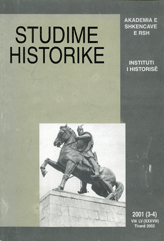PROFILI I NJË QYTETI SHQIPTAR TË KOHËS OSMANE: GJIROKASTRA GJATË SHEK.XV-XVI
THE PROFILE OF AN ALBANIAN TOWN OF THE OTTOMAN TIME:GJIROKASTER DURING THE XV-th - XVI-th CENTURIES
Author(s): Ferit DukaSubject(s): History
Published by: Qendra e Studimeve Albanologjike
Keywords: town of Gjirokaster; establishment of the Ottoman rule; Gjin Zenebishi; Albanian sandjak; Christian population of Gjirokaster
Summary/Abstract: The town of Gjirokaster has a long and rather interesting history. This centre has been especially preferred by the local and foreign rulers because on the enviable strategic position of the place (it controlled all the routes going into and coming out in the valley of Drinos). They have established here their head-quarters giving, so, to Gjirokaster the attributes of the administrative centre of the different political unities created in these regions. At least, from the depth of the Middle Ages, this town is mentioned in the chronicles and other historical testimonies which cast light on the various aspects of the political, economic and cultural developments taking place in the course of the centuries in Albania, especially in its southern part (Epirus). After the definitive conquest of Gjirokaster and of the other Albanian regions by the Ottomans and the establishment of the Ottoman rule in these regions this town and chief centre of the principality of Gjin Zenebishi became chief centre of the Albanian sandjak, while the former ruler of these parts would die (year 1418). Nevertheless, the death of Gjin didn’t mark also the end of the Zenebishe. Besides the name with which the Ottomans named the vilayet of Gjirokaster (vilayet-i Zenebish), new direct descendants of this family, successors of Gjin, continued to be weighty actors in the history of Albania of the XV-th century. The Christian population of Gjirokaster even in the last decades of the XVI-th century, apart from the fact that a part of it was islamized and had created the Moslem community, continued to make up the overwhelming majority of the inhabitants of the town. From about 70 Moslem houses which can be counted in this time, referring always to the Ottoman defter of the year 1583, the number of the Christian houses registered in the same document was 232. Nevertheless, the demographic growth of the town has found its expression more in the quantity of the houses than in that of the quarters. At the same time, part of the changes undergone by the town since the year 1583 is also the all-embracing changes of the names of the quarters (strangely enough none of the quarter’s names of the year 1520 does not exist any more in the year 1583).
Journal: Studime Historike
- Issue Year: 2002
- Issue No: 01-02
- Page Range: 007-028
- Page Count: 22
- Language: Albanian
- Content File-PDF

